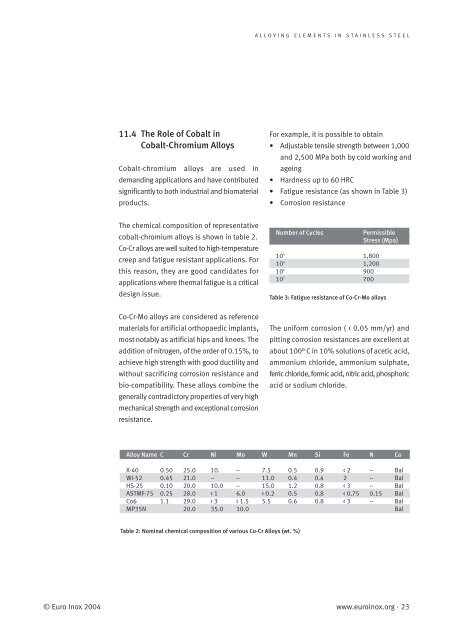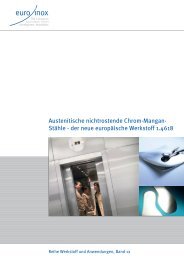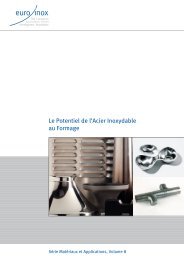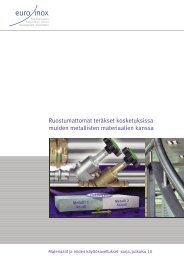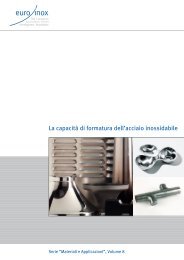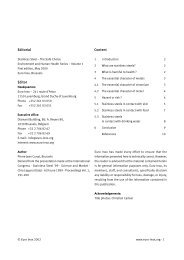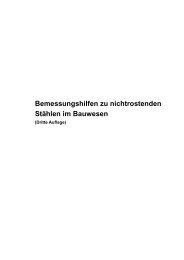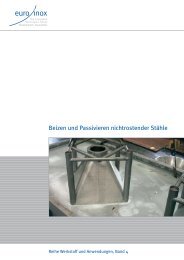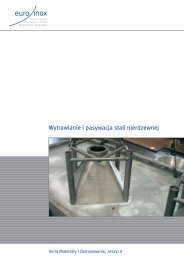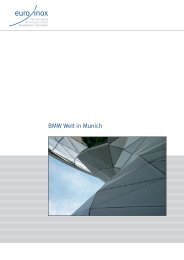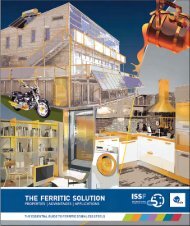Alloying Elements in Stainless Steel and Other Chromium - Euro Inox
Alloying Elements in Stainless Steel and Other Chromium - Euro Inox
Alloying Elements in Stainless Steel and Other Chromium - Euro Inox
Create successful ePaper yourself
Turn your PDF publications into a flip-book with our unique Google optimized e-Paper software.
© <strong>Euro</strong> <strong>Inox</strong> 2004<br />
11.4 The Role of Cobalt <strong>in</strong><br />
Cobalt-<strong>Chromium</strong> Alloys<br />
Cobalt-chromium alloys are used <strong>in</strong><br />
dem<strong>and</strong><strong>in</strong>g applications <strong>and</strong> have contributed<br />
significantly to both <strong>in</strong>dustrial <strong>and</strong> biomaterial<br />
products.<br />
The chemical composition of representative<br />
cobalt-chromium alloys is shown <strong>in</strong> table 2.<br />
Co-Cr alloys are well suited to high-temperature<br />
creep <strong>and</strong> fatigue resistant applications. For<br />
this reason, they are good c<strong>and</strong>idates for<br />
applications where thermal fatigue is a critical<br />
design issue.<br />
Co-Cr-Mo alloys are considered as reference<br />
materials for artificial orthopaedic implants,<br />
most notably as artificial hips <strong>and</strong> knees. The<br />
addition of nitrogen, of the order of 0.15%, to<br />
achieve high strength with good ductility <strong>and</strong><br />
without sacrific<strong>in</strong>g corrosion resistance <strong>and</strong><br />
bio-compatibility. These alloys comb<strong>in</strong>e the<br />
generally contradictory properties of very high<br />
mechanical strength <strong>and</strong> exceptional corrosion<br />
resistance.<br />
ALLOYING ELEMENTS IN STAINLESS STEEL<br />
For example, it is possible to obta<strong>in</strong><br />
• Adjustable tensile strength between 1,000<br />
<strong>and</strong> 2,500 MPa both by cold work<strong>in</strong>g <strong>and</strong><br />
age<strong>in</strong>g<br />
• Hardness up to 60 HRC<br />
• Fatigue resistance (as shown <strong>in</strong> Table 3)<br />
• Corrosion resistance<br />
Number of Cycles Permissible<br />
Stress (Mpa)<br />
10 4 1,800<br />
10 5 1,200<br />
10 6 900<br />
10 7 700<br />
Table 3: Fatigue resistance of Co-Cr-Mo alloys<br />
The uniform corrosion ( < 0.05 mm/yr) <strong>and</strong><br />
pitt<strong>in</strong>g corrosion resistances are excellent at<br />
about 100° C <strong>in</strong> 10% solutions of acetic acid,<br />
ammonium chloride, ammonium sulphate,<br />
ferric chloride, formic acid, nitric acid, phosphoric<br />
acid or sodium chloride.<br />
Alloy Name C Cr Ni Mo W Mn Si Fe N Co<br />
X-40 0.50 25.0 10. -- 7.5 0.5 0.9 < 2 -- Bal<br />
WI-52 0.45 21.0 -- -- 11.0 0.4 0.4 2 -- Bal<br />
HS-25 0.10 20.0 10.0 -- 15.0 1.2 0.8 < 3 -- Bal<br />
ASTMF-75 0.25 28.0 < 1 6.0 < 0.2 0.5 0.8 < 0.75 0.15 Bal<br />
Co6 1.1 29.0 < 3 < 1.5 5.5 0.6 0.8 < 3 -- Bal<br />
MP35N 20.0 35.0 10.0 Bal<br />
Table 2: Nom<strong>in</strong>al chemical composition of various Co-Cr Alloys (wt. %)<br />
www.euro<strong>in</strong>ox.org · 23


